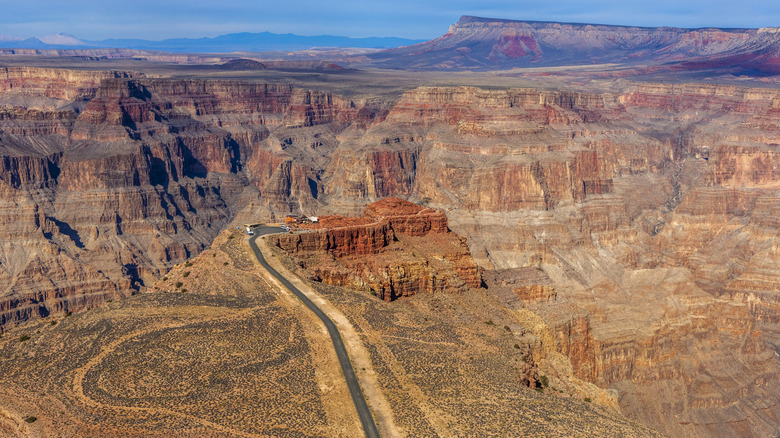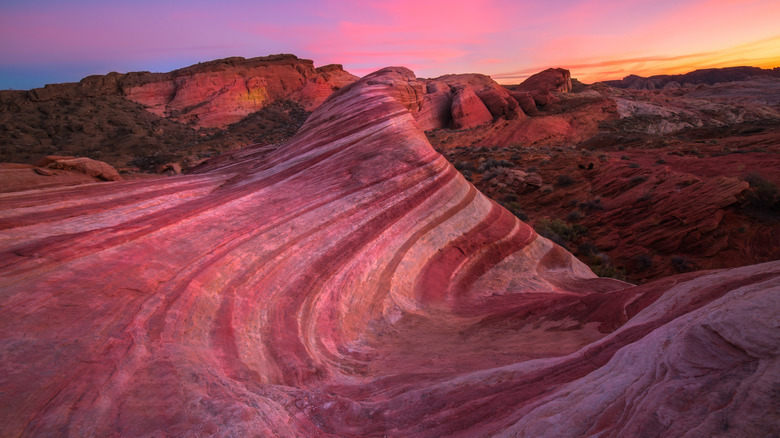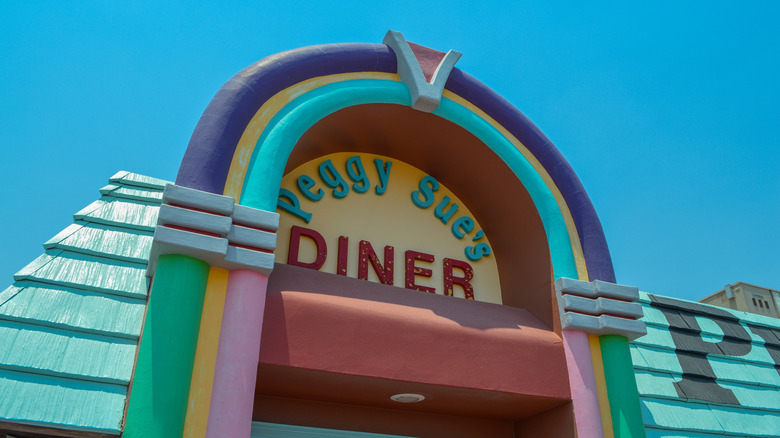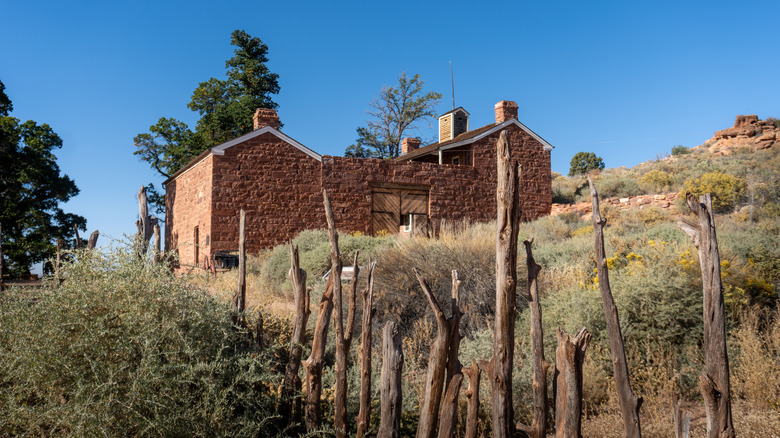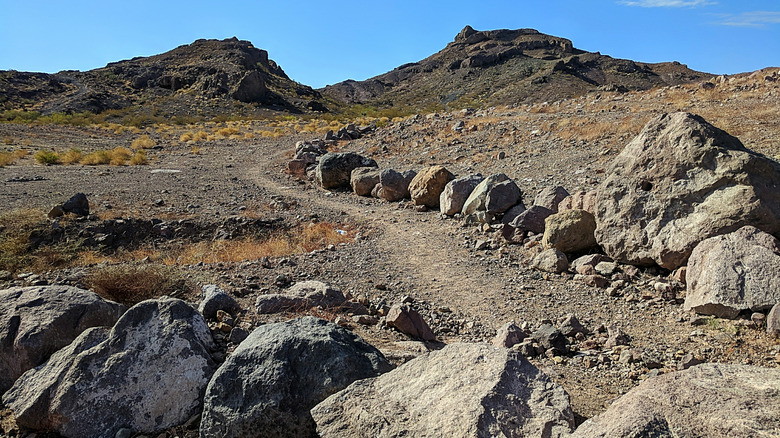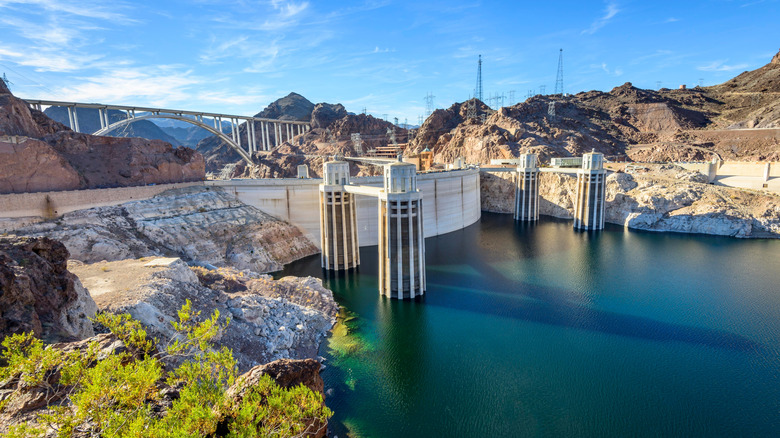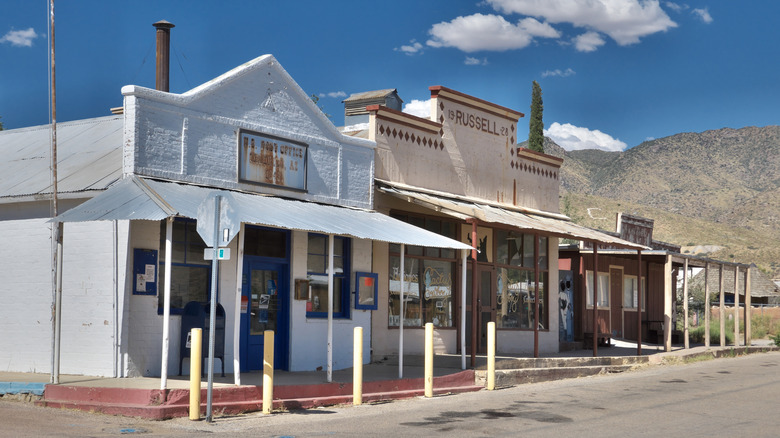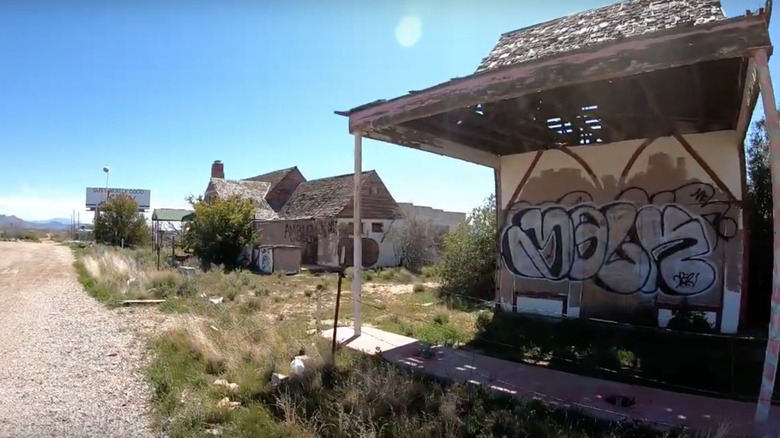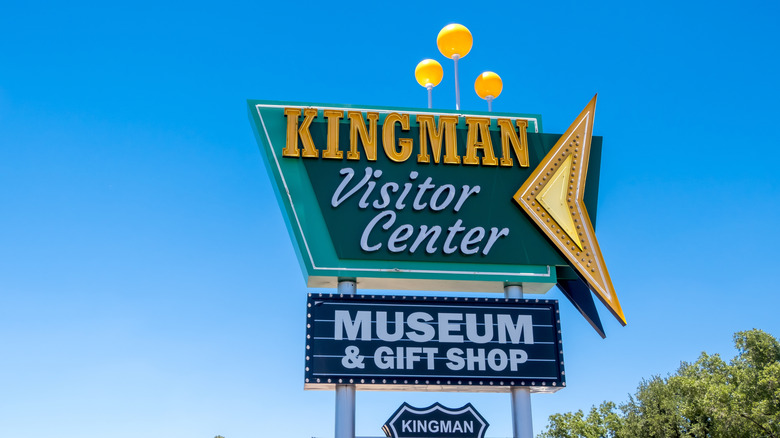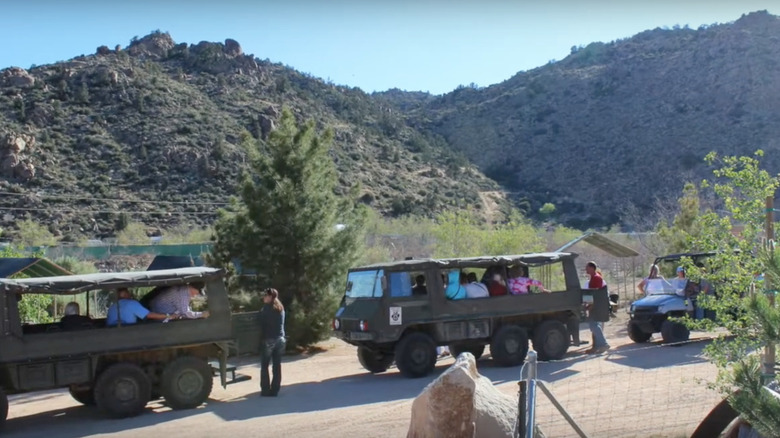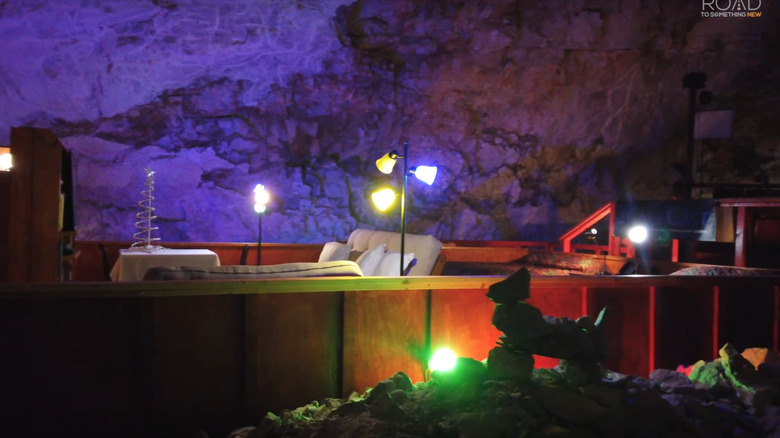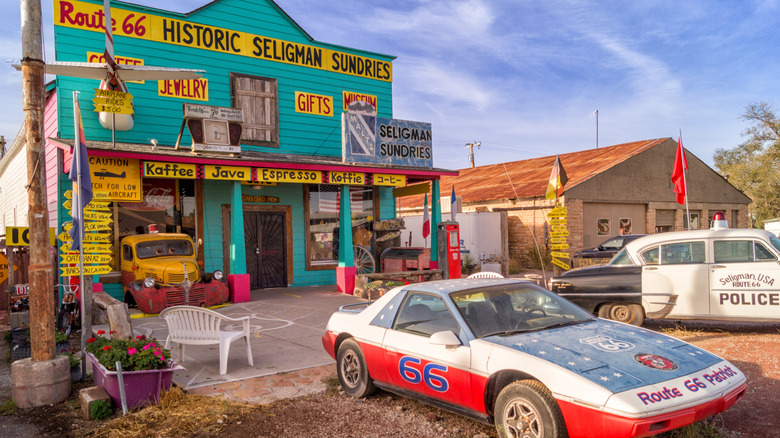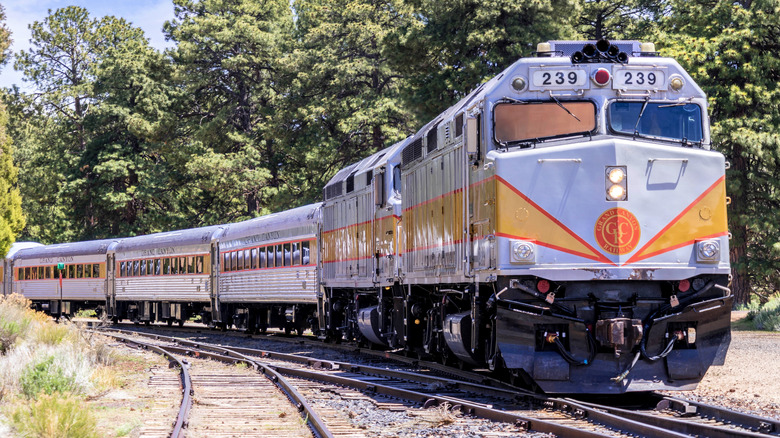The Best Stops On A Breathtaking Road Trip Between Las Vegas And The Grand Canyon
Las Vegas and the Grand Canyon, two of the Southwest's most popular destinations for both American and international visitors, offer vastly different experiences. The former, the "most fun city in the United States," is an arena of man-made spectacles, where resorts, facilities, and shows pitch relentless campaigns of one-upmanship. The Grand Canyon, on the other hand, is a hypnotic marvel of nature, full of sinewy curves, and layers of dazzling colors, though it is also the national park with the highest number of deaths in the country. Combining these seeming opposites when making a trip to the Southwest is an easy sojourn since they are only a few hour's drive apart. But rather than make the journey in a straight shot, why not make some stops along the way, to see a few of the other sites that make this part of the U.S. so alluring?
There are two main routes between Las Vegas and Grand Canyon National Park, depending on whether you visit the park's North Rim or South Rim. We've separated the stops below based on routes to the North Rim and the South Rim respectively, and arranged the stops as they would appear sequentially, from west to east (i.e., as travelers would encounter them when driving from Las Vegas to the Grand Canyon). The North Rim has fewer stops partially because fewer people visit the North Rim, and it's only open for five months, from mid-May to mid-October. Trips to both rims promise interesting things along the way, so whichever one you decide to take, we have you covered.
Valley of Fire State Park, Nevada
On the drive to the North Rim, travelers can get to Valley of Fire State Park from the Las Vegas Strip in less than an hour. For fans of sinuous geological formations, and certainly for anyone who enjoys the sight of the Grand Canyon, the rocks and vistas at this Nevada park will likely fill them with awe. The park, full of fiery vistas, unfurls across 40,000 acres of terrain, with Aztec sandstone combined with the more docile colors of limestone weaving a magical spell. There are also petroglyphs, and petrified trees that are more than two millennia old, and the combination is a mesmerizing tableau that showcases the beauty of nature. Expect to see towers of red rock, or slopes where the smoothed layers of different colored rocks look like some fantastical ice-cream swirl come to life in a giant way.
Elsewhere visitors will see arches of rock, narrow canyons, dusty plains peppered with grand formations, and a visitor center that puts it all into historical perspective. And yet, despite the arid conditions — the mercury regularly pushes past 100 degrees Fahrenheit in the summer, making this a more comfortable destination during winter, when the temperature can break the 70s — there is plenty of life in the Valley of Fire State Park. Cactus thrives there, including cholla and beaver tail, as does creosote bush and brittlebush. Bird lovers can take a hike and look out for roadrunners, house finches, and ravens, while four-legged dwellers include lizards, spotted skunks, and coyotes. If you are really lucky, you might spot a desert tortoise.
Peggy Sue's 50's Diner, Nevada
It will take less than an hour to drive from Valley of Fire State Park to this diner in Mesquite that supplies travelers with a journey back in time. As the name suggests, the diner celebrates the decade when the birth rate literally boomed, the Cold War ramped up, and Elvis Presley started his ascent to musical royalty. There are pictures of "The King" slung on the walls of the diner, as well as guitars hanging from panels, and photos that recall the 1950s. A diner counter is lined on one side by bright-red vinyl upholstered diner.
Even the menu harks back to yesteryear, with 50s-era writing, and menu items under headings like "Big Boppin Burgers," and "Sock Hop' Wraps." The food extends to classic diner fare, as expected, so diners can anticipate hot cakes, burgers, steaks, fries, thick, frothy milkshakes, and bottomless coffee. The whole experience is wrapped in tunes pulled straight from the 50s.
Pipe Spring National Monument, Arizona
After fuelling up, drive about 90 minutes to the next stop. This destination is named for Pipe Spring, a waterway that proved important for early residents of this area. Kaibab Paiute used the waters from the spring to cultivate plants and feed livestock. Later, in the 1850s, Mormons settled in the region and changed the terrain, ushering in a period of fractious relations between the settlers and the Native Americans.
Travelers will be able to learn about the history of the Kaibab Paiute and other tribes in this part of Arizona with a stop at the on-site museum. But this isn't the only education that the monument provides. There are ranches there, with horses and cattle, talks by rangers and experts, forts on the land, cabins, and of course, the serene terrain of the Southwest. Visitors can explore gardens, with orchards that produce peaches, plums, and apricots, and land that generates traditional Native American crops. Hikes along the Ridge Trail take in grand scenery, from sandstone cliffs to desert flats.
Sloan Canyon National Conservation Area, Nevada
When driving to the South Rim of Grand Canyon National Park from the heart of Las Vegas, the most speedy route entails hopping onto I-11, heading southeast, and then eventually linking with I-40. This conservation area represents a minor detour from that route, but it is definitely worth making the stop. This natural expanse of the Mojave Desert was officially mandated in 2002. It sits south of Las Vegas, pushing up against Henderson, an artsy city full of charm, and spreads for more than 48,000 acres.
The serene mountains there are a counterpoint to the glitz, lights, and towers of Sin City, but it is an easy escape for travelers seeking some tranquility in nature. One of the highlights of a visit to the area is the chance to see the wealth of petroglyphs, concentrated in a section known as the Sloan Canyon Petroglyph Site. This represents a valuable piece of anthropological history, with thousands of images etched onto hundreds of panels. Also within Sloan Canyon, fans of the outdoors can explore the North McCullough Wilderness, a vast, untouched tract with volcanic structures like ash falls and lava flows.
Hoover Dam, Nevada and Arizona
Expect a drive of less than 30 minutes from Sloan Canyon Conservation Area to this iconic dam on the edge of Lake Mead. Completed in the 1930s as a way to control the repeated flooding of the Colorado River, Hoover Dam is named after President Herbert Hoover, who was instrumental in its construction. Not only has the dam helped to tame the floods, it has also been key for providing a stable source of water for Los Angeles, and supplying electricity for thousands of local households.
On a more simplistic level, it is an impressive structure to see in person. Just consider some of the trivia. It rises more than 700 feet from its base to the road on top, and ornamented parapets rise even higher. The dam used 3.25 million cubic yards of concrete, enough to make a 16-foot-wide highway from New York to San Francisco, a city with a new park with breathtaking bay views. It took over 20,000 workers to build the dam which endures a pressure of 45,000 pounds per square foot at its base. Visitors can get a sense of this grand scale during guided tours of the curved dam, or the power plant that it feeds. They can also take the opportunity to visit Lake Mead, which extends up and outward from the dam.
Chloride, Arizona
The hour-long drive from Hoover Dam to this former mining town takes place mostly on Route 93. Visiting Chloride, which was founded in 1863, almost feels like a step back in time. Only a few hundred people live in the town these days, and there aren't any large retail outlets or fancy establishments. Instead, visitors will find a hotel, a church, a handful of small stores, and a general store where you can pick up daily items. The town also has the oldest operating post office in the state and is the oldest mining town in Arizona.
It is a far cry from the town's identity during the mining boom when thousands lived there. Silver was one of the main products of the mines — the town gets its name from silver chloride — although gold, zinc, turquoise, and lead were also found in the area. The mining industry began to wane at the onset of World War II when many miners were needed for the war, and silver prices dropped. But Chloride continues to persevere, and visitors can wander its quiet streets, and learn all about the town's history at the museum run by the Chloride Historical Society.
Santa Claus, Arizona
From Chloride, it's a short hop — about 10 minutes — to the ghost town of Santa Claus. The name of this former hamlet is a big clue as to its genesis, and role in this dry, dusty part of Arizona. It was founded in 1937 by Ninon Talbott, who moved to Arizona from California. Talbott was drawn to the desert, and coupling that with her fondness for cooking, she opened a hotel that was called the Christmas Tree Inn. The restaurant menu was inspired by the North Pole and featured dishes like reindeer and chicken soup, and Eskimo fruit cocktail.
The food was a hit, even impressing food writer Duncan Hines, and as word spread, and the town's popularity grew, Santa Claus expanded to include a gift shop and even a post office. The last of these was one of the key attractions for visitors, after all, who could resist sending a letter or postcard that was postmarked as coming from "Santa Claus." But the town's gimmicks didn't last forever, and by the mid-1990s, nothing was left. Now, travelers come here to gaze at abandoned structures with peeling paint and walls covered in graffiti and imagine the heyday of this town where it was Christmas any time of the year.
Kingman, Arizona
Motor 14 miles southeast of Santa Claus, and you'll find yourself in the small city of Kingman, population 35,000. Kingman sits on Route 66, a storied route for a perfect U.S. road trip. Travelers can learn all about that seminal, iconic American thoroughfare with a visit to the Arizona Route 66 Museum. First opened in 2001, the museum presents large dioramas, murals, photos, and other mediums to trace the travelers and history of the "Mother Road," as Route 66 is sometimes called. Visitors will also see finely preserved old cars, and at the Route 66 Electric Vehicle Museum annex, be able to pore over almost 30 electric vehicles, some of which are more than 100 years old.
Kingman also offers more than just motoring memorabilia. In Downtown Kingman, travelers will find a museum of history and art, a locomotive train exhibit, a tree-lined park, and many historic homes. Among them, Bonelli House is a period house from the 1900s that was a family home for many years. For fun-seekers, other avenues include the Desert Diamond Distillery (makers of spirits), a bowling alley, and a brewery that makes mead.
Keepers of the Wild Nature Park, Arizona
Continue on Route 66 for about 40 minutes, and you'll come to this refuge that houses more than 100 rescued animals, including tigers. The sanctuary first opened in 1995 and is a non-profit that tasks itself with safeguarding its creatures and also its 175 acres of wild lands, including canyons. The park is the brainchild of Jonathan Kraft, an entertainer from Vegas who used big cats in his shows.
He felt conflicted about employing these majestic creatures on stage, keeping them trapped in cages when they weren't performing, and decided to make a radical change and alter the course of his career. He opened Keeper of the Wild Nature Park, and today works as an educator and activist on animal rights. Today, the stock of rescued creatures that call this part of Arizona home include bears, primates, coyotes, and birds. Travelers can help with the upkeep of this commendable project through visits, guided tours, adoptions, and simple donations.
Grand Canyon Caverns, Arizona
After enjoying the outdoors, and the animals that live in it, these caverns promise an experience that is firmly all about the interior. The drive from Keepers of the Wild Nature Park will take about 30 minutes along Route 66. Sure, there are places to stay and eat above ground, but the real fun is what lies below the surface. The caverns are over 50 million years old and serve as a backdrop for some unique moments beyond just touring the actual caverns. Inside the arched caves, travelers can dine at the Crystal Restaurant, located 200 feet underground.
While the food is prepared on the surface, meals are served on tables with checked tablecloths and four seats, and come with wraparound views of the largest cave in the complex. For travelers that feel weary, and want to extend the subterranean atmosphere for a little longer, they can consider booking the Cavern Suite. The room comes with two queen beds, a futon, a basic bathroom, a mini-fridge, and even a television. One thing you will be guaranteed all the way down there — total darkness.
Seligman, Arizona
Expect another 30-minute drive to get to Seligman from the Grand Canyon Caverns. Seligman holds a special place in the lore of Route 66 because this is where the Historic Route 66 Association of Arizona was formed. It was in February 1987 that a group met at the Copper Cart restaurant. The opening of nearby I-40 just south of town threatened its livelihood since the interstate bypassed Seligman. At that meeting in the Copper Cart, a town barber called Angel Delgadillo spearheaded the drive to create an association to promote interest in the iconic Route 66.
That organization was instrumental in renewing interest in the roadway, and when the piece of it between Seligman and Kingman was officially notated at Historic Route 66, Seligman took on the mantle of being the birthplace of Historic Route 66. The association continues to promote Route 66, and it played a key role in getting the road recognized as a National Scenic Byway. The town is a cool place to spend an hour, to get a feel for a town that seems looped into America from a few decades ago. You'll see some old cars in various states of roadworthiness, and be able to visit a retro-diner and a gift shop run by Angel Delgadillo and see plenty of Route 66 signs.
Williams, Arizona
The final stop is a 40-minute drive from Seligman. There is much to do in Williams, and visitors could easily spend many hours in the town. Perhaps, most famously, it is known as the departure point for the railway to the Grand Canyon. The vintage train is aimed primarily at day-trippers who want to see the Grand Canyon for a few hours and then return. The daily departure leaves Williams every morning, and the train comes back in the evening.
More than just a train ride, the journey starts with a mock gunfight in Williams, and onboard, cowboys with banjos, fiddles, squeezeboxes, and more, sing tunes to passengers. But you don't have to get on the train to get a taste of the Wild West. Williams is home to Wild West Junction, an attraction that recreates a town from the frontier. There are places to stay and eat at and buildings that look like they reside in the 1800s. For thrill-seekers, Canyon Coaster Adventure Park offers a roller coaster, and tubing in both the summer and winter. Wildlife lovers might want to drop by Bearizona, where visiting options allow for walkers and also drive-through guests. Animals that live there include wolves, bears, bison, jaguars, and reindeer
